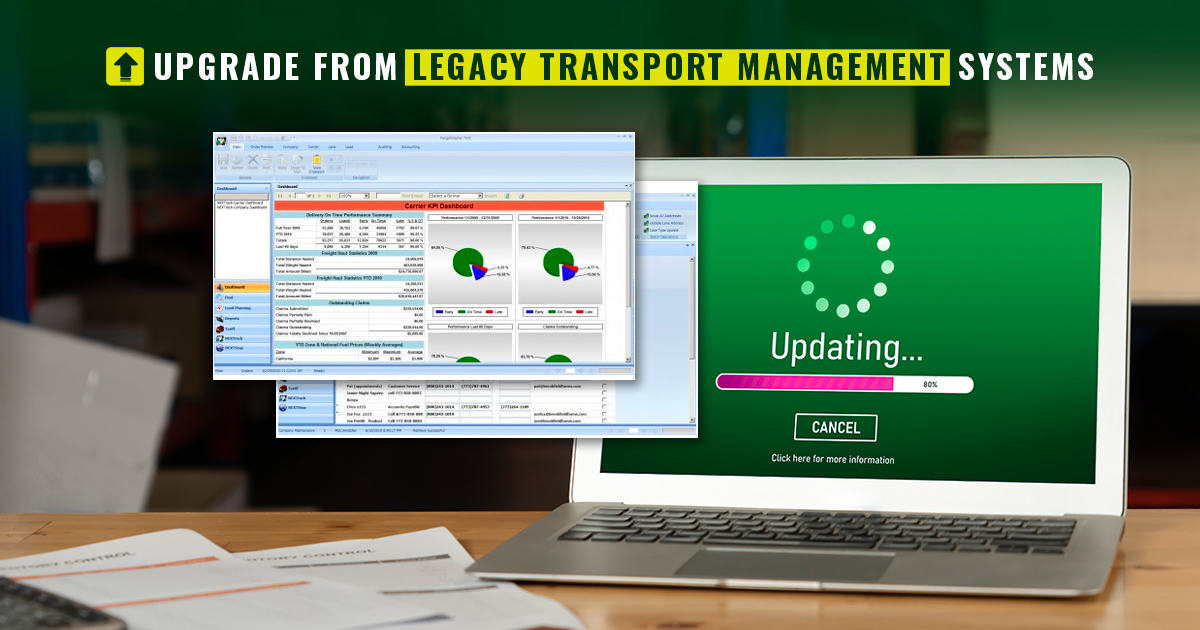
We, humans, are a funny bunch; no matter how quickly we progress technologically, many of us find comfort in the familiar as a global community. We’ll wear out an old pair of shoes because they have sentimental value while neglecting our footwear needs.
We’ll repeatedly order the same dish from a restaurant, ignoring the delicious and overwhelming variety available. We’ll stick to traditional methods of doing business because “that’s how we’ve always done it,” despite overwhelming evidence that new and innovative methods are far superior.
There’s nothing wrong with liking what you like and leaning toward the familiar. However, when it comes to doing business and remaining competitive in an ever-evolving marketplace, there is no longer any room for sentimentality.
So, as comfortable and reliable as your old legacy transport management systems might be, at some point or another, you will have to modernize these processes or be left behind by your competitors.
What Is a Legacy Transport Management System?
In short, a legacy transport management system is a piece of software/hardware used to manage your supply chain and logistics, which is outdated, yet still in use. Legacy systems may be functional, but that doesn’t make them scalable.
Typically, businesses using legacy systems cannot properly connect with new trading partners, cloud applications, or any other emerging solutions. That said, the integration restrictions are just a very small aspect of a much bigger issue.
What Are the Risks of Maintaining a Legacy System?
Greater security risks
Dated legacy systems present security risks as they use older technologies that are no longer supported by the company that created them in the first place. When you lack regular maintenance and updates, legacy systems become littered with vulnerabilities, thus putting your valuable data and your business at great risk. There are few things as critical as data security in this modern digitalized world.
Inefficiency
While most legacy systems were certainly efficient back when they were constructed, with the rapid progress of technology, they are no longer half as good as they once were. As a result, older systems can begin to slow down and impede productivity, despite how comfortable and familiar they might be.
A lack of data insights
The beauty of modern software applications is that they utilize advanced reporting metrics and comprehensive data insights to support critical business decisions with actionable information – built into the platform. But unfortunately, when it comes to data and visibility, legacy systems cannot keep up.
Is Relying on a Familiar ‘Legacy’ System for Transport Management Bad?
We understand why business owners may find it easier to stick with their legacy systems. For one thing: they can be difficult to replace when said system plays a critical role in powering vital business processes, and the thought of mixing things up can be petrifying.
Not only that but switching out your legacy system with new and modernized software requires a significant up-front investment. That said, legacy systems almost always take up extra resources, relying on specialized skill sets to manage, thus remaining somewhat stagnant and inflexible.
We also understand that for many people, the tools and systems they use and have relied on for years work well for their business and are continuing to meet their daily needs. In any case, everything has a shelf-life, and that’s not to say that there aren’t far superior tools and systems that can work well for your business and bring even greater advantages.
An inability to meet new business challenges in an ever-digitalized world will limit your business’s ability for growth. Likewise, maintaining a legacy system prevents businesses from scaling, no matter how you view it.
When you bring in new partners and services, migrate applications and processes to the cloud, or begin to support big data initiatives to remain competitive, legacy systems will not offer the capabilities needed to do so successfully.
So, to answer the question: “is it that bad to stick with a legacy transport system?” – the answer is yes, most likely. It might not seem dire or urgent, but the limitations of a legacy system and the advantages of new software enjoyed by your competitors might be the silent killer for your business.
Unconvinced? We urge you to keep reading.
Ask the Following Questions About Your Existing Set-Up
If you are undecided about modernizing your existing setup, we encourage you to ask the following questions:
- Can your existing system accept and process multiple forms of data from all partner systems and internal apps?
- Can you properly customize integrations to connect new trading partners and applications?
- Is your existing system able to handle a significant increase in data volume from new trading partners and applications?
- Is your system able to identify errors in data processing, and can they be resolved quickly?
- How much money is tied to keeping your legacy transport management systems active (e.g., chargebacks, maintenance, and development expenses)?
Suppose you ask any of the above questions and find that your answers are unsatisfactory. In that case, it is time for you to seriously consider migrating from your legacy transport management systems to new cloud-based solutions.
The Importance of Integration
While there are many considerations when contemplating the modernization and digitalization of your IT processes, integration is arguably the most important.
By consolidating integrations among your business systems, you will improve your data-exchanging capabilities, bolster your new partner relationships, and reduce the overall risk of costly errors.
Understandably, one of the biggest reasons that may be holding you back is the fear of having to disrupt your existing business workflows and processes while trying to implement a new system. If this is the case, stick around, and we can talk you through how Transportify can alleviate those concerns shortly.
 |
Why Is It So Important to Modernise Legacy Transport Systems?
Again, if you are comfortable with your current system, you may wonder about the fuss. Is it that important to modernize your legacy transport management system? Here’s what you need to know:
- Gain the ability to onboard new partners and applications with greater speed and efficiency.
- You can provide much faster responses when changing partner requests.
- Enabled access to real-time data transaction views.
- Offer end-to-end data governance when being audited to ensure compliance.
- Be able to receive automated notices in case of any issues, thus quickly identifying and resolving costly errors.
SEE ALSO:
We Can Help You With Your Legacy Transport Management System Replacement Strategy
As mentioned earlier, we understand how daunting it can be to change from a legacy system to a modern transport management system (TMS). The “if it isn’t broken, don’t fix it” argument springs to mind, mainly if it means that you may need to interrupt your current operations.
Fortunately, at Transportify, we can help you integrate your legacy transport system into a new, modernized TMS with as little disruption to your day-to-day. In doing so, you can continue doing business as usual and connect, integrate, and analyze every single piece of data that flows through your systems from the customers, partners, suppliers, and external applications, including your internal business systems.
Simply put, we can provide you with a complete and comprehensive solution for your business-to-business and data integration requirements.
You should endeavor to remain ahead of the curve when managing your transport and logistic requirements. The supply chain game is forever evolving; unless you are up to date with the latest innovations, you will be left in the dust.
Your competitors are doing it.
Now it’s time for you to get yours. Are you interested in learning more? Please do not hesitate to contact us today, and one of our friendly advisors will gladly answer any questions you might have.
 | or |
Frequently Asked Questions:
What is the difference between legacy and modern transport management systems?
🚚 There are a few key differences between legacy and modern transport management systems. First, legacy systems are typically designed to be used with traditional transportation methods, such as trucks, trains, and ships. On the other hand, modern transport management systems are designed to be used with newer transportation methods, such as planes and automobiles. Second, legacy systems are more complex and difficult to use than modern transport management systems. Finally, legacy systems cannot often track and manage shipments in real-time, while modern transport management systems typically offer this capability.
What is the advantage of upgrading from legacy transport management systems?
🚚 There are many advantages of upgrading from legacy transport management systems to modern systems. The first key advantage is increased efficiency. Modern transport management systems are designed to be much more efficient than their legacy counterparts. This means you can expect increased productivity and cost savings after upgrading. Second, improved customer service and modern transport management systems offer improved customer service features. This can help you win new business and keep your existing customers happy. Last, reduced costs. Upgrading a modern transport management system can also help you reduce overall costs. This is because these systems are often more affordable to maintain and operate than legacy systems.




 INSTANT QUOTE
INSTANT QUOTE

 Chat
Chat